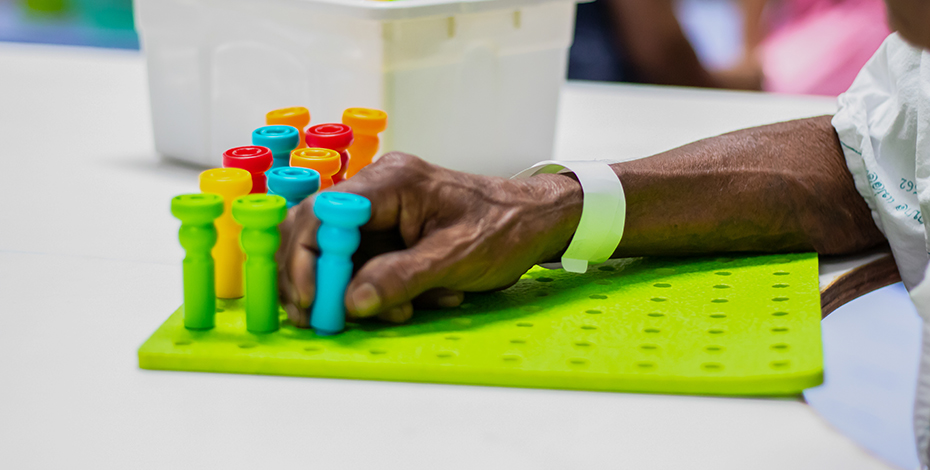
Implementing CIMT for stroke survivors

JOURNAL OF PHYSIOTHERAPY An interdisciplinary team from Perth, including two APA Neurological Physiotherapists, has systematically reviewed the evidence from qualitative and quantitative studies to determine the perceptions and experiences of constraint-induced movement therapy among stroke survivors, their carers, their therapists and managers of rehabilitation services. First author Ashan Weerakkody answers a few questions about the review.
Why did you decide to undertake this systematic review?
Constraint-induced movement therapy (CIMT) is the most researched and best supported upper limb intervention we have in stroke rehabilitation, with Level 1 evidence supporting its efficacy at all time points in the stroke recovery continuum (acute, subacute and chronic).
Despite this, very few eligible stroke survivors receive CIMT as part of their upper limb rehabilitation.
To understand why effective interventions are not routinely adopted in clinical practice, it’s important to understand the views of all stakeholders.
Several studies had been conducted with stroke survivors and clinicians from a range of settings and countries
but these individual studies did not provide a clear understanding of the complex factors that influence CIMT programs in stroke rehabilitation.
To support widespread adoption, we sought to provide a single point of reference on the views and experiences of this effective yet under-provided intervention.
How is traditional CIMT delivered?
CIMT consists of three key components:
• a suite of behavioural strategies known as the Transfer Package
• intensive practice with the stroke-affected upper limb
• use of a restraint on the less affected hand.
Traditional CIMT programs involve six hours of daily intensive practice and wearing of the restraint for 90 per cent of waking hours over two weeks (10 weekdays).
This protocol can be difficult to deliver in standard clinical settings due to resource and labour constraints.
Modified programs were therefore developed with reduced amounts of active practice and time wearing a restraint.
Modified and traditional CIMT programs appear to be equally effective in terms of upper limb outcomes and we included both interventions in this review as they are often described interchangeably.
How many qualitative and quantitative studies were you able to include in the review?
We included seven qualitative studies, one mixed methods study and six quantitative studies. From these 14 studies, 1570 participant perspectives were captured.
What themes did you identify from the qualitative research?
Our thematic synthesis of the qualitative data generated four analytical themes.

Ashan Weerakkody.
The first theme identified challenges (eg, fatigue, frustration and time constraints) and enablers (eg, therapist support, leadership support and interdisciplinary collaboration) of CIMT programs.
The second theme emphasised the need for therapists to have the knowledge and skills to deliver CIMT programs, with the backing of institutional enablers such as leadership support to provide appropriate therapy space and clinical time.
The third theme explored CIMT’s individual components and how it differs from other upper limb rehabilitation interventions.
The fourth theme identified motivating factors for stroke survivors to participate in CIMT, such as the desire to improve and return to meaningful activities, and their post-program reflections.
Did the quantitative research reinforce these themes or did it identify other issues?
Therapists having the knowledge and skills to deliver CIMT was an essential factor identified in both the qualitative and quantitative data.
Clinicians who had undergone formal training and received mentoring support were more likely to provide CIMT programs to stroke survivors.
Beyond this, responses varied depending on whether the participant had prior CIMT experience.
Therapists with experience delivering CIMT programs identified their institution and health management as enablers to delivering CIMT programs, while those without CIMT experience reported that management was
unlikely to support it.
Similarly, therapists and patients without CIMT experience reported that the high amount of practice would be too intense for stroke survivors.
However, those with CIMT experience saw this intensity as a positive factor contributing to functional improvements.
By including quantitative data in this review, we identified a gap between perceptions of CIMT and what is experienced.
This insight may help guide future behaviour change interventions to change perceptions about CIMT.
Where do you think research in this area needs to go next?
Physiotherapy prides itself on being an evidence-based profession. E
xtensive research has demonstrated that CIMT is effective for people with mild-to-moderate upper limb impairment, so research needs to focus on clinicians and health services implementing CIMT across a range of clinical settings.
A few implementation studies have been published but more studies are needed across various settings and funding models (public, private and NGO) for CIMT to become standard care in Australia and internationally.
>> Ashan Weerakkody APAM MACP is an APA Neurological Physiotherapist working in public and private community-based neurological rehabilitation. He is a PhD candidate at Edith Cowan University, investigating the implementation of CIMT within a large home-based rehabilitation service.
© Copyright 2024 by Australian Physiotherapy Association. All rights reserved.





